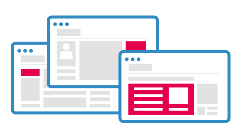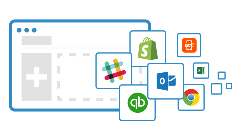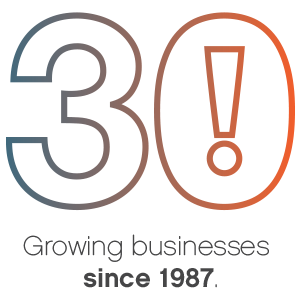What Is A Sales Pipeline and Why Does A Small Business Need One?
The goal with a sales pipeline in your small business is to create a snapshot of current clients and prospects and the position they are in the sales process. Showing what the expected sales are going to be for a current time and or with a representative from the company. Below is a Sales Pipeline 101 for you and your small business.
The Difference Between A Sales Funnel & Sales Pipeline
- There is often a lot of confusion centered around the terms, “sales pipeline” and “sales funnel”. Do you know the difference between the two? If not, it’s perfectly fine. Let’s define and dissect each term, to hopefully eradicate future misunderstandings.
What is a Sales Funnel?
A sales funnel (also known as a sales process or revenue funnel) refers to the process of converting a prospect into a customer, with the objective of persuading them to purchase a product or service by guiding them through a multi-layered model. There are several phases in a sales funnel, and they include:
- Awareness – This is where a prospect becomes aware of a brand either by accident (social media, friend, google search, ad) or through an alluring offer, and decides to take the first step and reach out via a website form, content download, survey, etcetera. Regardless of how they arrive, the objective now is to continue their journey through the funnel.
- Interest – After a prospect has become aware of a brand, they then commence to conducting their own research on your product/service and your competitor’s product/service to determine which brand is best for them.
- Decision – After conducting extensive research, the prospect is now sure that they want to buy said product/service, but now have to decide between multiple options. This is typically when a brand presents it’s best offer to a prospect to close the deal.
- Action – At the bottom of the sales funnel, a lead is ready to make the decision. They’ll either purchase your product/service or go with a competitor. If a customer decides to purchase from your business, then the sales process extends to another step, “retention.” This is the act of persuading a customer to continue to buy from your company after their first purchase.
What is a Sales Pipeline?
A sales pipeline refers to a specific list of actions taken by a sales representative, with the objective of converting a prospect into a customer. This process allows sales reps to monitor the status of every deal with every prospect, for the purpose of ensuring that sales goals are met. Similar to a sales funnel model, a sales pipeline model consists of stages that help the flow of prospects transition from point A to point B. These stages include:
- Qualification – In order to transition a prospect down a sales process, a sales representative will need to ask a lead questions like, what their needs are, what their budget is, and so on. Then use that information to determine if they are likely to make a purchase.
- Meeting – Whether in person, over the phone, or through email, after a prospect has been qualified, it is now time to have a discussion with said lead to figure out their needs and find an ideal solution.
- Proposal – After the meeting, a sales representative will take the information discussed, and provide a lead with a comprehensive quote disclosing information such as the services/products that will be provided and cost of said services/products.
- Closing – After a quote has been provided to a prospect and negotiations are conducted to work out the best deal for both parties, contracts are then signed and the lead is then officially converted into a customer.
Although a “sales funnel” differs from a “sales pipeline,” there is one similarity that binds both terms. That is the funnel-like structure of the process that works to push through prospects who are truly interested or open to being persuaded to purchase a product or service. For small businesses owners looking to learn more about incorporating a sales pipeline or sales funnel into their business operations to increase the efficiency of their sales and marketing efforts.
What are the Sales Pipeline Stages?
A sales pipeline is an effective tool used by sales representatives to help transition new leads down a layered funnel-like system that ends with said lead becoming a customer. It is essentially a visual representation of the revenue expected to be generated on a deal or during a period of time, and consist of multiple stages, including:
- Initial Contact – The initial contact refers to the first time a lead has contact with your brand, and this interaction usually stems from the marketing efforts (ads, forms, surveys, social media interactions, google searches) of your business’s marketing department. After the initial connection has been established, the lead is then passed off to a sales rep to gather more information.
- Qualification – The process of qualifying a lead is determined by the criteria set by your business’s sales department. Fully qualified prospects are assessed through their answers to a host of questions (i.e., what do you do for work, can you afford our product or service, what do you need, how soon do you need it, etcetera), used to determine their viability as customers. If the likelihood of a prospect becoming a customer is high, then they are then transitioned to the next phase.
- Meeting – Once a lead is qualified, the next phase in the process is a meeting via a phone call, email, or in person. This is typically when a business unleashes a top sales rep or account exec to discuss the intricacies of the service or product the prospect is interested in purchasing.
- Proposal – After the meeting, and once the prospect has confirmed that they are still interested in what your business is offering, this is when a proposal is sent out to the prospect, detailing what product or service will be provided, how much the product or service will cost, and the duration of the contract (if necessary). It is not uncommon for prospects to try and negotiate for a better price or weigh their options with a competitor’s products or services to ensure that they are getting the best deal before signing.
- Closing – Once both parties have read over the proposal, and asked all remaining questions, this is when the contract is signed and the lead has officially transitioned from that to a customer.
After the deal is done, it is now time to try to increase the value of the customer by finding opportunities to increase revenue generated per sale, increase customer retention, and lower the expenses associated with serving of a customer by implementing sales strategies like up-selling and cross-selling.
What is Up-selling?
Up-selling is an important sales technique designed to increase customer retention by persuading a customer to spend more per sale. It specifically refers to the process of convincing a customer to purchase a more expensive item by offering premium or upgraded version of the product or service they have chosen.
What is Cross-Selling?
Cross-selling is another important sales technique designed to increase customer retention by persuading a customer to spend more. It specifically refers to the process of convincing a customer to purchase an item related to or that complements the item that they have just purchased. For small businesses owner’s looking to refine their sales pipeline and increase the effectiveness of every stage of the process, Act! is here and ready to help you reach your goals. We provide an all-inclusive CRM designed to facilitate the process of acquiring new leads, assist your sales reps in transitioning them through your sales pipeline more efficiently, and helping you increase customer retention.
Increasing Your Bottom Line With Your Sales Pipeline
A well-managed sales pipeline is vital to improving your business’s bottom line. A sales pipeline refers to a detailed process designed to guide a sales representative down the path of converting a prospect into a customer. The stages of this process include:
- Initial Contact
- Qualification
- Meeting
- Proposal
- Closing
Hopefully, if all goes according to plan and a sales representative is able to close a deal, they will have then transitioned into the next phase, and that is customer retention.
What is Customer Retention?
Customer retention refers to the ability of a business to keep a customer returning to their brand to purchase products and services without losing their business to competitors in the same market. Customer retention is important because having a customer spend more money over a specified period of time increases their value, and for the business, it’s a more cost-effective option compared to customer acquisition, which refers to the process of acquiring new customers. Customer acquisition is the least sought after alternative due to the resources that go into getting new business (i.e., time and money).
What is Bottom Line?
The bottom line refers to a business’s net earnings, profits, and income. The “bottom” aspect of bottom line references the location of the net income amount on a business’s income statement. For a business to increase its bottoms line using a sales pipeline means that the business is improving it’s net earnings while simultaneously reducing the expenses associated with improving it. So, the question here is, how can a business use their sales pipeline to improve its bottom line? The answer is simply to ensure that your pipeline is running efficiently. Here are some common issues that can begin to negatively affect a sales reps ability to close a deal, which in turn can negatively impact a business’s bottom line.
Clogged Sales Pipelines – Jammed packed sales pipelines cause a tremendous amount of confusion for sales representatives, and often lead to prospects being left in limbo inside your pipeline. Besides the confusion of having leads who may or may not be interested in purchasing a product or service, a clogged sales pipeline can provide misleading sales projections at the end of the quarter, causing sales representatives to expect bigger earnings than what they have actually generated.
Poor Communication Strategies – Communicating efficiently and strategically is extremely important in regards to the process of converting a new lead into a customer. Prospects in every stage of the sales process need to be communicated with, in an appropriate manner, with the purpose of helping push them into the next phase of the pipeline. This often requires a bit of trial and error to understand what works and what doesn’t, in regards to your technique.
Minimal Knowledge of Leads – If your company is fortunate enough to have generated a lead, the best way to lose them to your competition is by having little understanding of what service or product they want or need. Getting to know your lead on a deeper level is the best way to gain their confidence. Maintaining contact with a prospect and following them on their journey through your website is an extremely effective way to gather intel and use it to convert them into a customer. Sales reps can also use the information from the first sale to continue to up-sell and cross-sell a customer to enhance their value and increase your business’s bottom line. If you’re a small business owner looking for ways to improve upon your business’s sales pipeline, with the objective of increasing your bottom line, Act! provides an all-inclusive CRM that is designed to manage the flow of prospects, and provide real-time feedback to enhance your pipeline’s effectiveness.
How Can Act! CRM Help Enhance Your Sales Pipeline
A sales pipeline refers to the position of a prospect in your unique sales process, and details the actions that need to take place in-order for a sales representative to transition a prospect interested in a deal to a paying customer. Using all-inclusive software like Act!’s CRM to support the conversion of leads is an essential element to the growth of your business and management of your sales pipelines. Some of the tools that Act!’s CRM possess include:
Dynamic Sales Pipeline Management – Businesses have the option to use Act! to generate a creative sales system to manage the flow of prospects through each stage of the process, or implement one of their own. This feature tracks and stores an array of data not limited to the probability of closing a deal. Users are presented with a digital display of their sales pipeline in an easily digestible manner, in which they can use to project revenue and adjust the process according to their liking.
Rich Customer Management – Act!’s CRM keeps an extensive record of interactions with prospects such as emails, notes, activities and much more, for the purpose of communicating with them in an efficient manner to help close deals.
Marketing Automation – Marketing automation combined with our CRM forms to become an extremely effective tool for marketing departments. Businesses can enhance the way they communicate with prospects and customers by setting defined criteria, that when triggered sends out automated correspondence to intended recipients to begin the process of transitioning them through the sales pipeline.
Actionable Business Insights – Users have full access to live metrics with engaging graphical dashboards, detailing company (individual, team, and business) performance, including information regarding marketing, sales, and KPIs (key performance indicator health), to assist in better decision making. Users can view these details using one of over 50 pre-built reports, or create your own using our report designer, and export reports for your team using Microsoft Excel, PDFs, or simply through email for further viewing.
What Are Some Sales Pipeline Mistakes That Act! Helps You Mitigate?
Shirking Pipelines – This often occurs when sales teams are handling sales pipelines with outdated software. During a period when prospects a flowing through your sales pipeline, it is normal (when using outdated software) to neglect prospects, but the consequences of disregarding leads will be felt once the pipeline inevitably dry’s up. Using a CRM like Act! makes the likelihood of losing prospects due to neglect difficult, because of its ability to automatically store a prospects data and alert a user when they’ve entered the pipeline.
Congested Pipelines – Congested sales pipelines can cause inaccuracies when it comes to predicting future sales. Having prospects in your system who you’ve lost contact with for quite some time will have caused you to fall far below your forecasted projections. CRM’s work with users to ensure that their expectations are closer to reality than fantasy, by monitoring prospects interactions and informing user’s of potential congestion within their sales pipeline.
Losing Leads – Losing leads is equivalent to losing money. Follow up processes are extremely important in regards to generating revenue through deals, and Act!’s CRM solution partners with marketing teams to maintain consistency in regards to reaching out to prospects to make every attempt (based on the criteria set by the user) to convert them into consumers before eventually moving them into separate folder to prevent sales pipeline congestion.
Improving Your Sale’s Pipeline With Act!
Act! incorporates all of the tools embedded within it’s CRM to manage sales pipelines, and enhance the efficiency of the process. To learn how Act! can help grow your business by generating more sales through deals. Make your small business the best it can be with the next generation of Act! Contact us today or if you like follow us over to our how to improve sales in your small business.
Adaptable

Act! works like you work, equipping you with a variety of configuration options from lightly personalised to completely customised. Set security rules, automate unique processes, and more. Highly trained Act! Certified Consultants1 can help create your Act! experience.
Everywhere

Act! goes where you go, enabling you to be productive from wherever you work—the office, home, or the road. Get to the details you need whether you’re online or offline. Sophisticated offline sync capabilities keep everyone in the business up to date.
Connected

Act! likes what you like, keeping you connected to the tools and apps you love like Slack™, QuickBooks® Online, Shopify, and hundreds more via Act! Connect. Direct integration with Outlook®, Google™, and Excel enables seamless interaction.
What you get with Act! CRM
- Powerful sales and marketing features that fuel business growth.
- Freedom to tailor an Act! experience to fit your unique needs.
- Flexible deployment with Cloud, on-premises, and hybrid options.
- Exclusive Act! Insider benefits that keep you current, covered, and connected.
- Peace of mind, because Act! is the proven, trusted choice of small and mid-sized businesses.
- Extensive online training resources that help you get the most from Act!.
- Expert technical support2 with phone, live chat, and email options.
Rest-assured, Act! is the proven, trusted choice
Act! is the proven, trusted choice of entrepreneurs, sales teams, and small and mid-sized businesses—and has been for over 30 years. Act! helped establish the CRM category and has been leading the way ever since, acquiring over six million users in 100+ countries, so you know you’re in good company and in good hands. And while Act! is simple to learn and easy to use, we’re here to help with expert technical support2, digital self-help, and a vast network of Act! Certified Consultants1 if you need it.

Don't take our word for it! See why our customers love Act!:



